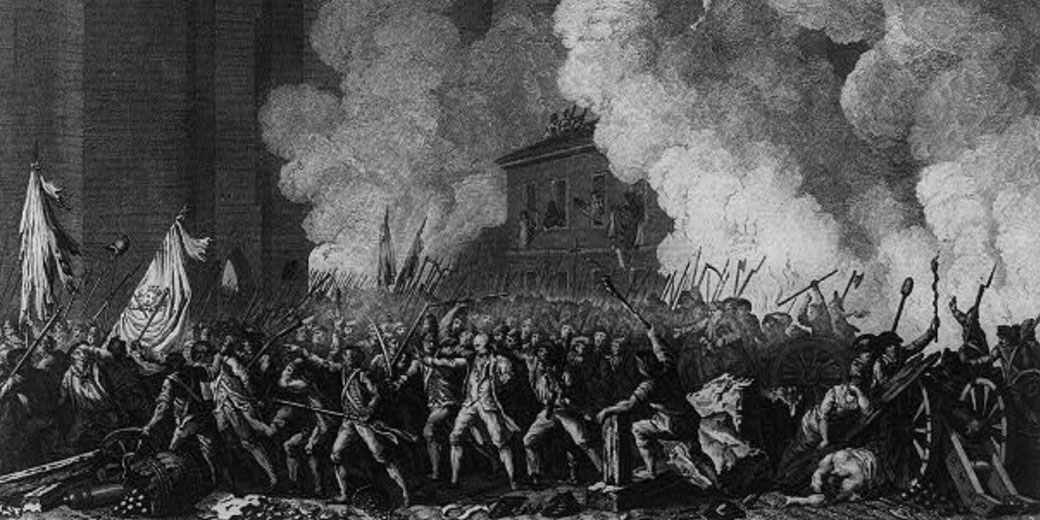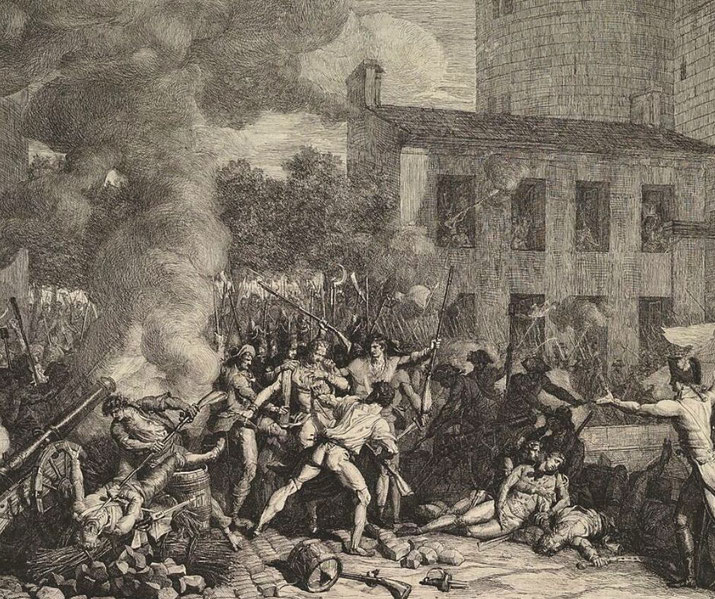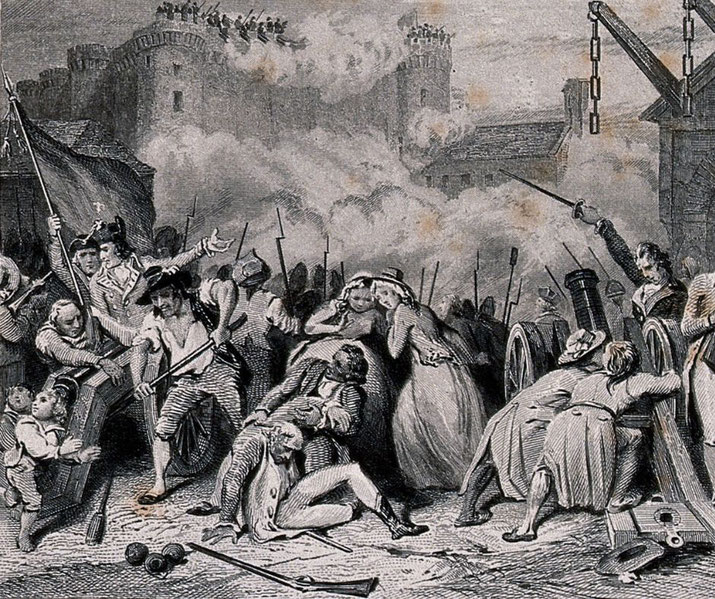The Storming of the Bastille and the birth of Revolutionary France

The Storming of the Bastille, which took place on July 14, 1789, is a pivotal moment that heralded the onset of the French Revolution.
This event symbolized the end of an era and the beginning of a new epoch in French history.
The Bastille, once a fortress and later a state prison, had become emblematic of the Bourbon monarchy's oppressive rule and unchecked power.
Its fall at the hands of Parisian revolutionaries signaled a profound shift in the balance of power. The events of that day, driven by a mix of economic hardship, political unrest, and a fervent desire for liberty, set the stage for a transformative decade in France.
Why was France in crisis?
The latter half of the 18th century saw France grappling with a series of compounding crises.
Economically, the nation was burdened by a mounting debt, much of which was accrued due to its involvement in the American Revolutionary War from 1775 to 1783.
This financial strain was exacerbated by an inefficient tax system, where the nobility and clergy, the First and Second Estates respectively, were largely exempt, placing the brunt of the burden on the Third Estate, which comprised the commoners.
Socially, Enlightenment ideas about democracy, liberty, and equality were gaining traction, challenging the age-old feudal structures and the divine right of kings.
Philosophers like Voltaire, Rousseau, and Montesquieu had sown the seeds of dissent, questioning the very foundations of the monarchy and advocating for a more equitable society.

What was the Bastille?
The Bastille, originally constructed in the 14th century as a fortress to defend Paris from English forces during the Hundred Years' War, had over time evolved into a state prison.
By the late 18th century, it had come to represent much more than its stone walls and imposing towers would suggest.
For many Parisians and French citizens, the Bastille was a looming embodiment of the Bourbon monarchy's oppressive regime and its arbitrary use of power.
While the prison itself held a relatively small number of inmates, the secrecy surrounding its operations fueled public imagination and fear.
Tales of individuals imprisoned without trial, on the basis of the notorious "lettres de cachet" – royal warrants that allowed for imprisonment without public record – circulated widely.
These stories, whether entirely factual or embellished, painted a picture of a place where freedoms were snuffed out, and the monarchy's critics vanished into the shadows.
Moreover, the Bastille's strategic location in the heart of Paris made it a constant, visible reminder of the monarchy's omnipresence.
Its thick walls and fortified design were not just defensive measures against external threats but also served as a stark warning to the city's inhabitants of the consequences of dissent.
As Enlightenment ideas about individual rights and liberties gained momentum, the Bastille's oppressive symbolism became even more pronounced.
The dramatic events leading up to July 14, 1789
The year 1789 was a tumultuous one for France, with a series of events rapidly unfolding, setting the stage for the iconic storming of the Bastille.
The financial crisis, exacerbated by France's involvement in the American Revolutionary War and an inefficient tax system, had reached a critical point.
To address this, King Louis XVI convened the Estates-General on May 5, 1789.
However, what was intended as a forum to discuss fiscal reforms quickly became a hotbed of political unrest.
The representation and voting system of the Estates-General was a point of contention.
Each of the three estates – the clergy, the nobility, and the commoners – had one vote.
This meant that the Third Estate, representing the vast majority of the French population, could easily be outvoted by the combined First and Second Estates.
Frustrated by this imbalance and the lack of meaningful reform, the Third Estate declared itself the National Assembly on June 17, 1789, asserting that it was the true representative body of the French people.
The tension between the National Assembly and the monarchy intensified when, on June 20, the assembly's members found their meeting hall's doors locked and guarded.
Viewing this as a direct affront, they reconvened in a nearby tennis court. Here, they took the Tennis Court Oath, pledging to remain united until a new French constitution was established.
This act was a clear defiance of royal authority.
In the following weeks, Paris became a city on edge. Rumors swirled that the king was planning to use military force to dissolve the National Assembly.
These fears seemed to be confirmed when Louis XVI began amassing troops around the capital.
Amidst this backdrop, on July 11, the king dismissed Jacques Necker, the popular finance minister seen by many as sympathetic to the Third Estate's cause.
This decision was met with public outrage, leading to widespread protests and the erection of barricades in the streets of Paris.
What happened during the Storming of the Bastille?
On the morning of July 14, 1789, a large crowd of Parisians gathered outside the Bastille.
Their initial intent was to procure the weapons stored within its walls, driven by the urgent need to arm themselves amidst the escalating tensions in the city.
As the crowd's size swelled, so did its determination, and what began as a quest for arms soon took on a more symbolic objective: to challenge the very emblem of royal tyranny.
The fortress was defended by a garrison of around 100 soldiers and another 30 Swiss mercenaries.
As the crowd's demands grew louder, the governor of the Bastille, Bernard-René de Launay, attempted to negotiate.
However, these efforts were in vain. The crowd's impatience turned to action as some began to scale the outer walls, while others sought to break down the drawbridge.
By mid-afternoon, the situation had grown increasingly volatile. The defenders of the Bastille, perhaps nervous and uncertain of how to handle the escalating situation, opened fire on the crowd.
This act of aggression further inflamed the Parisians, turning their mission into one of vengeance as much as liberation.
As the hours wore on, reinforcements for the revolutionaries arrived, including mutinous French guards who brought with them much-needed expertise and cannon firepower.
The tide began to turn. By late afternoon, realizing the situation was becoming untenable and fearing a massacre, de Launay ordered a ceasefire and signaled his intent to surrender.
The gates of the Bastille were opened, and the jubilant crowd poured in. The fortress-prison, which had stood for centuries as a symbol of royal authority and oppression, had fallen to the people of Paris in a matter of hours.

The aftermath
The fall of the Bastille sent shockwaves throughout France. News of the event spread rapidly, not just in Paris but across the entire nation, serving as a rallying cry for those who had long felt oppressed by the Bourbon monarchy.
The audacity of the Parisian mob and their success in capturing such a formidable symbol of royal power emboldened other cities and towns to rise up, leading to widespread civil unrest.
King Louis XVI, who was at the Palace of Versailles when he received news of the Bastille's capture, was reportedly taken aback.
Famously, when informed of the day's events, he asked the Duke of La Rochefoucauld, "Is it a revolt?" to which the Duke responded, "No, sire, it's a revolution."
This exchange underscored the gravity of the situation and the realization that the old order was under serious threat.
In a bid to quell the escalating tensions, Louis XVI made several immediate concessions.
He publicly announced the recall of Jacques Necker, the popular finance minister whose dismissal had been one of the catalysts for the storming.
The king also ordered the withdrawal of royal troops from Paris, effectively acknowledging the city's newfound autonomy.
The National Assembly, bolstered by the events at the Bastille, continued its work on drafting a new constitution for France.
The revolutionary fervor was further solidified when, on August 4, 1789, the Assembly adopted a decree that abolished feudal privileges, effectively ending centuries-old traditions that had benefited the nobility and clergy at the expense of the common people.
In Paris, the newly formed municipal government, the Paris Commune, took steps to maintain order in the city.
The Bourgeois Militia, which had played a role in the storming, was transformed into the National Guard, with the Marquis de Lafayette, a hero of the American Revolution, as its leader.
Why do the French still celebrate it today?
The storming of the Bastille, while a singular event in the timeline of the French Revolution, carried a weight of significance that extended far beyond the walls of the fortress-prison.
Its impact was both immediate and enduring, shaping the trajectory of the revolution and leaving a lasting legacy in its wake.
In the immediate context of 1789, the fall of the Bastille signaled the undeniable power of collective action.
It showcased that the common people, when united by a shared cause and driven by a fervent desire for change, could challenge and even topple symbols of entrenched authority.
This realization not only emboldened the French populace but also served as a warning to the ruling elite about the shifting dynamics of power.
The event also played a crucial role in galvanizing support for the revolutionary cause.
Across France, the success of the Parisian mob inspired similar uprisings, leading to the widespread questioning of feudal privileges and the eventual dismantling of the old social order.
The momentum generated by the storming was instrumental in propelling the National Assembly's efforts to draft a constitution and redefine the relationship between the monarchy and its subjects.
Beyond the immediate context of the French Revolution, the storming of the Bastille left an enduring legacy.
It became emblematic of the broader struggle for liberty, equality, and fraternity – ideals that would come to define the spirit of the revolution.
The event's symbolic power was recognized early on, leading to the establishment of July 14 as Bastille Day, a national holiday in France.
Celebrated with fervor each year, it serves as a reminder of the sacrifices made and the victories achieved in the pursuit of a more just and equitable society.
Globally, the storming of the Bastille and the subsequent events of the French Revolution had profound implications.
They challenged monarchies and empires, inspiring revolutionary movements and uprisings in various parts of the world.
The ideals of the revolution, encapsulated in part by the events of July 14, provided a blueprint for other nations seeking to break free from oppressive regimes and establish more democratic forms of governance.
What do you need help with?
Download ready-to-use digital learning resources
Copyright © History Skills 2014-2025.
Contact via email
With the exception of links to external sites, some historical sources and extracts from specific publications, all content on this website is copyrighted by History Skills. This content may not be copied, republished or redistributed without written permission from the website creator. Please use the Contact page to obtain relevant permission.





